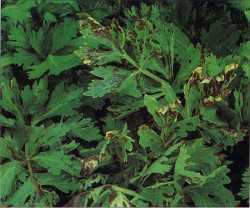Pest Of The Month: Bacterial Blight Of Celery

Identification
The initial symptoms are small water-soaked spots on the upper and lower leaf surfaces. As the lesions expand, they are delimited by leaf veins, which give them an angular appearance. In most cases, the lesions become dark brown. However, under dry conditions they may be lighter in color. The close proximity of seedlings and the environmental conditions in the seedbed at that time (hot and rainy weather) contribute to rapid development of the disease.
Lesions may coalesce to cover large areas of an infected leaf, but rarely appear on leaf petioles. Bacterial blight lesions appear similar to lesions caused by the early blight fungus (Cercospora apii), but are typically smaller, darker in color, and have a more water-soaked appearance. The margin of the lesions are more distinct than that of early blight, and chlorosis occurs more slowly. In addition, fungal growth may be observed on early blight lesions under favorable conditions.
Brown stem is a petiole necrosis of celery caused by the same pathogen. Unlike bacterial blight, which is present every year, brown stem is more sporadic, appearing every five or six years. When it does occur, however, it can be severely damaging to the celery crop. Brown stem causes more curling and stalk rot than bacterial blight. The principal symptom of brown stem is a brown discoloration over the entire petiole. Although brown streaks may be seen along the whole petiole, the base of the stalk receives the greatest amount of damage. Symptoms intensify closer to harvest as the plant approaches maturity.
Survival And Spread
Bacterial blight is favored by warm and humid conditions, and might be difficult to control during wet weather. The bacteria can be spread from plant to plant by rain, irrigation, or on machinery and people. Symptoms appear within days of the bacteria entering a plant’s tissue through natural openings or wounds. The reasons for the sporadic appearance of brown stem outbreaks are unknown, but are thought to be related to unusually wet winters with high humidity, frequent rainfall, and windy conditions.
Management Methods
In seedbeds, mechanical transmission can be minimized by trimming when foliage is dry. Fertility management is important. Growers should avoid foliar application of nitrogen during warm, wet periods and over-fertilization with soil-applied nitrogen. Minimizing mechanical contact with the plants, once set in the field, also may help reduce spread.
A preventive spray program with copper is the primary tool available to growers for the management of the disease. Unfortunately, strains tolerant to copper fungicides have been reported in South Florida. In addition, streptomycin resistance is still widespread despite very limited use in the Everglades area over the past few decades.









